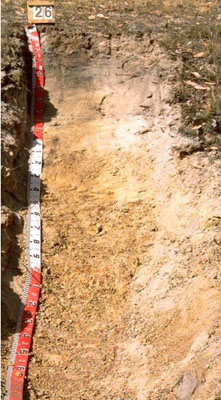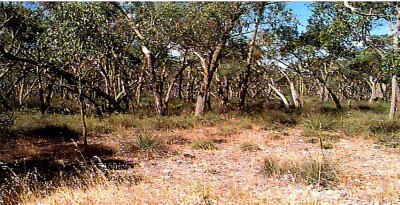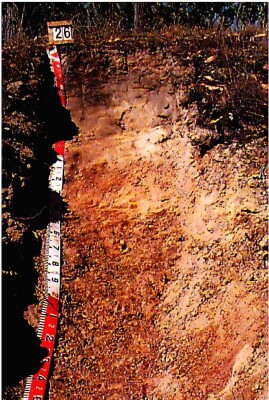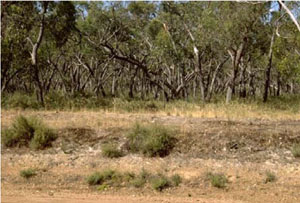LSWW26
|
| LSWW26 |  Bleached-Ferric, Yellow KUROSOL | |
|
Location | Coleraine-Edenhope Road, Kadnook, western Victoria | |||
|
Landform | Plain | |||
|
Geology | Quaternary Lowan Formation: aeolian fine to medium grained dune sand | |||
|
Element | Plain | |||
Horizon | Depth (cm) | Description | ||
A1 | 0–10 | Disturbed horizon. | ||
A2 | 10–30 | Greyish brown (2.5Y5/2); sand (organic); weak to massive structure; weak consistence when dry; pH 5.7: | ||
A2 | 30–75 | Light yellowish brown (2.5Y6/3), conspicuously bleached, with a few faint orange and brown mottles; sand; massive (structureless); weak consistence when dry; pH 5.2: | ||
Bs | 75–90 | Brownish yellow (10YR6/6) with common distinct orange mottles; sand; ferruginous and indurated sandstone are abundant; pH 5.5. | ||
B2 | 90–130 | Brownish yellow (10YR6/6) with many prominent coarse red and orange mottles; light medium clay; strong fine to very fine polyhedral structure; clay skins on the ped-faces; pH 5.5: | ||
B3 | 130+ | Abundant very coarse red prominent mottles; partially weathered sandstone and clay; clay skins on the clay-ped faces; horizon grading towards BC. | ||
| Management considerations | ||||
| ||||
Horizon | Depth (cm) | pH (water) | pH (CaCl2) | EC dS/m |
A1 | 0–10 | |||
A2 | 10–30 | 5.7 | 4.4 | <0.05 |
A2 | 30–75 | 5.2 | 4.2 | <0.05 |
Bs | 75–90 | 5.5 | 4.4 | <0.05 |
B2 | 90–130 | 5.5 | 4.3 | <0.05 |
B3 | 130+ |
| Site: LSWW26 | Land Unit: Sand Plains and Rises |
| Aust. Soil Class.: Bleach-Ferric, ?, Yellow CHROMOSOL (very thick sandy surface) (confidence level 4) | |
 | General Land Unit Description: This land unit comprises areas with reasonably deep sand deposits, mainly north of the Kanawinka fault. The vegetation commonly marks the distinct changes from a landscape comprising of deep sand to one of shallow sand. The major tree species on the deep sand is brown Stringybark, with an understorey of heath vegetation, such as Blackboys and Tea Trees. Yellow Gums prefer the shallower sandy topsoils. The major landform in this land unit is gently undulating plains where there are gentle rises and low dunes. The common soil type on the gentle rises and low dunes is a sandy topsoil over mottled clay. The depth of sand is variable (often deeper than 50 cm) similar to this site, and can be as deep as two metres in some areas. The subsoils can be strongly acidic (Kurosol), although Chromosols and Sodosols also occur. Ferruginous nodules above the clay horizon are common. There are minor areas where dunes are the dominant landform. Podosols, Tenosols and soils with a deep sandy topsoil over a clay subsoil occur on the steeper dunes and Chromosols or Kurosols occur on the gentler dunes, with Sodosols and Vertosols on the swales and drainage depression. Podosols are soil types with a deep sandy profile that have a ‘coffee rock’ layer commonly at depth. |
Site Description:
| Geology: Quaternary aeolian | Landform pattern: Undulating plains and rises |
| Position in landscape: Upper slope | Internal drainage: Moderately well drained |
| Ap | 0-10 cm | Disturbed horizon. |  |
| 1A1 | 10-30 cm | Greyish brown (2.5Y5/2) sand (organic) weak to massive structure, weak consistence when dry. pH 5.7. | |
| 1A2 | 30-75 cm | Light yellowish brown (2.5Y6/3) sand, conspicuously bleached, a few faint orange and brown mottles, structureless, weak consistence when dry. pH 5.2. | |
| Subsoil | |||
| 1Bs | 75-90 cm | Brownish yellow (10YR6/6) sand, distinct orange mottles are common, ferruginised iron and indurated sandstone are abundant. pH 5.5. | |
| 1B2 | 90-130 cm | Brownish yellow (10YR6/6) light medium clay, many prominent coarse red and orange mottles are common, strong polyhedral structure (peds 5-10 mm breaking to 2-5 mm), clay skins on the ped faces. pH 5.5. | |
| 1B3 | 130+ cm | Partially weathered sandstone and clay, very coarse red, prominent mottles are abundant, clay skins on the clay ped faces. Horizon heading towards BC. |
Key Profile Features
- Deep sandy topsoil
- Hydrophobic topsoil
- Strong texture contrast between topsoil and subsoil
- Bleached A2 horizon
- Mottled subsoil
- Ferric pan
- Acidic topsoil
- Acidic subsoil
- Weathered sandstone occurring at depth



